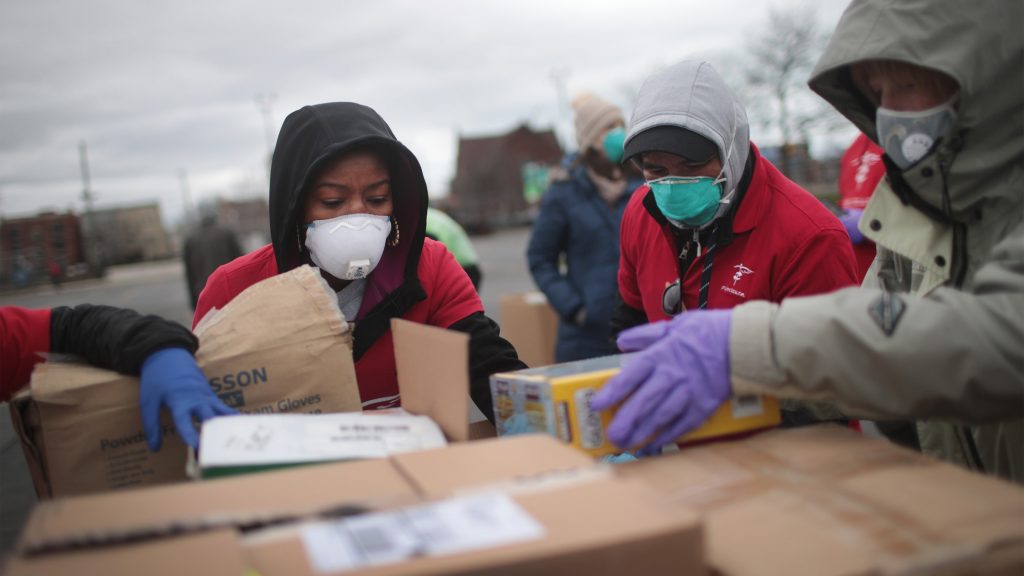Article written by Kelly Danckert
In her book, Emergent Strategy, Adrienne Maree Brown prompts the reader to reflect on the role community plays in our ability, at baseline, to survive, and at best, to thrive. She asks, “do you understand that your quality of life and your survival are tied to how authentic and generous the connections are between you and the people and place you live with and in?” This is an idea that has taken on new meaning in the time of COVID-19.
However, the idea that where you live, work, and play impacts your health is nothing new to public health. We know that our ability to achieve good health lies not within our individual behaviors and choices, but in the systems and structures around us – the built environment, education attainment, housing status, access to care – in short, the social determinants of health. Public health frameworks enable us to look at these determinants and how they impact individuals, communities, and populations. What community organizing does is accomplish this on the micro level by leveraging relationships and connections within a community to catalyze change through connection, empathy, and interdependence.
In the time of COVID-19, community interdependence has never been more essential to our health and well-being. Just days after cases of COVID-19 began breaking out in Massachusetts, neighborhood organizers were already getting mutual aid groups off the ground. Mutual aid is a system entirely comprised by volunteers where communities take on the responsibility of caring for one another rather than forcing individuals to fend for themselves. And often, mutual aid networks provide organizers with direct access to those most vulnerable: those without health care, elders, the immuno-comprised, the undocumented, and more. What started off as a Google Doc from MAMAS (Mutual Aid Medford and Somerville) is now a website, a hotline, and a roadmap for communities across the Commonwealth to replicate. As of May 18, there are 34 neighborhood mutual aid networks in communities across the state from Fall River to Williamsburg.
These neighborhood pods started off to meet urgent needs like housing, food, and money. What the networks have grown to include are things like  neighborhood group chats where folks can check in with each other, parent groups to share resources on remote learning (or to just commiserate and offer an empathetic ear), and artists offering virtual dance, yoga, and art classes. Our physical health demands things like food and housing, but our mental health craves connection, support, and radical interdependence in these times, and communities have risen to meet that need so beautifully because, like Adrienne Maree Brown alluded to, community organizers understand that our quality of life relies on the connections to our community.
neighborhood group chats where folks can check in with each other, parent groups to share resources on remote learning (or to just commiserate and offer an empathetic ear), and artists offering virtual dance, yoga, and art classes. Our physical health demands things like food and housing, but our mental health craves connection, support, and radical interdependence in these times, and communities have risen to meet that need so beautifully because, like Adrienne Maree Brown alluded to, community organizers understand that our quality of life relies on the connections to our community.
Community care has always existed, yet now it is being pushed into the spotlight. For National Mental Health Month, we wanted to celebrate all the communities and coalitions who are stepping up to assist neighbors and foster connections in a physically distant world. New research from the Kaiser Family Foundation has shown that the recent shelter-in-place orders, along with the unfolding crisis, has exacerbated many existing mental health issues with some communities being more vulnerable. Young people, older adults, communities of color, low-income folks, and undocumented individuals were identified as particularly vulnerable to adverse mental impacts related to COVID-19.
 Community coalitions can help address this on every level: by continuing to provide the resources to individuals, creating or participating in mutual aid networks, and advocating for the policy recommendations put forth by the Emergency Task Force on Coronavirus and Equity. On an individual level, this can look like having people in your coalition drop off food for neighbors or collect other needed resources. For interpersonal actions, creating a culture of checking in with neighbors and making sure they feel held and supported. However, what may be most impactful and sustainable for promoting community care is working with policymakers and other public health entities to promote policies that support the mental, physical, and emotional wellbeing of our communities.
Community coalitions can help address this on every level: by continuing to provide the resources to individuals, creating or participating in mutual aid networks, and advocating for the policy recommendations put forth by the Emergency Task Force on Coronavirus and Equity. On an individual level, this can look like having people in your coalition drop off food for neighbors or collect other needed resources. For interpersonal actions, creating a culture of checking in with neighbors and making sure they feel held and supported. However, what may be most impactful and sustainable for promoting community care is working with policymakers and other public health entities to promote policies that support the mental, physical, and emotional wellbeing of our communities.
For further reading on Emergent Strategy, you can find Adrienne Maree Brown’s book here.
